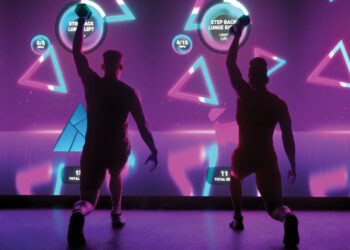Over the course of the COVID-19 pandemic and as gyms reopened, club operators noticed a lot more people navigating toward strength equipment, since it wasn’t as accessible from home. Now, many facilities are wondering if this trend will continue.
According to Bri Sexton, the chief product officer at BLAST with two locations in Atlanta, Georgia, during the pandemic people were forced to really evaluate their previous fitness habits, breaking the endless cycle of trying to just sweat out their lifestyle. Your members have likely realized they could supplement their cardio needs — in-home spin bikes, outdoor runs and bodyweight calisthenics — more easily than their strength training needs, simply from a space and equipment standpoint.
“Not having access to proper resistance training for a long enough time really demonstrated the impact it has on not only the physique but the psyche as well,” said Sexton. “After being so shaken in 2020, I think people are craving the feeling of strength and control more than ever, and lifting weights gives you that immediate feeling of empowerment. The fight for the squat rack is more alive than ever.”
Being a HIIT studio that balances both cardio and strength training in every workout, BLAST continues to educate clients on the benefits of each, and how to effectively utilize a variable-focus method to reach their goals. Sexton said they are incorporating longer blocks of strength training, and encouraging heavier weights and better form to facilitate more effective and safe workouts. “It’s not just about going harder on the cardio anymore,” ” she said. “That is a dated mindset and counterintuitive to most people’s goals.”
Jon Baraglia, the regional director of operations and fitness for Fitness Formula Clubs (FFC), located in the greater Chicago area, thinks there are a few factors influencing the disproportionate use of strength equipment, not just the pandemic.
“One factor really doesn’t have much to do with the pandemic as the popularity of strength-focused movements has been on the rise for some time now, including powerlifting and Olympic movements,” said Baraglia. “The other factor is it’s hard to find the same strength equipment options offered in gyms at home, and those who prefer to use those options were the first ones back after gyms reopened. As COVID-19 restrictions are easing, we see cardiovascular participation is also on the rise, with an increase in activities such as treadmill use and group fitness.”
The Bay Club Company, with 24 locations throughout California and Oregon, has also seen a positive trend in cardio usage as more individuals are vaccinated and members are ready to return to their routines. However, Jennifer Beaton, the senior vice president for The Bay Club, believes the focus on strength training will continue, as members do not have access to expensive weight equipment in their homes.
In order to keep up with this trend, The Bay Club is rearranging their strength set up to best serve their members, while keeping safety in mind.
“We are very fortunate to have large facilities with beautiful outdoor areas,” said Beaton. “We have assured we have a minimum of six to eight feet between pieces to allow members plenty of social distance. We have moved pieces outdoors to give our members a variety of options based on their comfort level.”
FFC has also taken space into consideration for their strength equipment areas. During the government mandated shutdown, the club used the opportunity to reinvest in many of their locations and rethink layouts.
“One of our strategies was equipment spacing, allowing for appropriate social distancing and creating a cleaner look and feel,” said Baraglia. “We also created additional space to add equipment that has been in high demand, such as additional squat racks with platforms and functional strength spaces on turf.”
Regardless if the coronavirus pandemic has caused a shift in the usage of strength equipment for your facility, there is no doubt it has caused the world to focus more on health and well-being. The industry has worked hard to build a better reputation around how people view the health and fitness world. The pandemic has allowed people to see exercise is not about getting ripped but rather living a healthier lifestyle.
This mentality shift is what excites Sexton as the industry moves, especially in terms of more people utilizing strength equipment to better their lives.
“I have been impressed and excited to watch the shift in public understanding on how strength training impacts physique, especially in the past two years or so,” said Sexton. “The fear of ‘bulking’ has been shattered and more women are embracing the weights as an effective way to change their bodies — inside and out. I love that being strong is the new focus. Fitness is becoming more about how you feel and what you can do with your body, rather than just how you look.”
Stay ahead in the fitness industry with exclusive updates!
Taylor Gabhart is the editor of Club Solutions Magazine. She can be reached at taylor@peakemedia.com.











